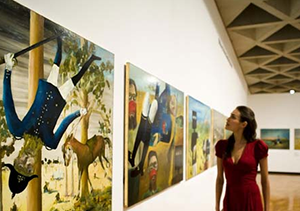OPINION: When visitors come to the Turner from the Tate exhibition at the National Gallery of Australia, the experience is to travel through time and space to early 19th century Britain. It was a time of social turmoil and war, when the French Revolution led to the rise of Napoleon and his defeat by the mighty British Navy. It is a beautiful illusion.
The Turner exhibition comes to Australia as part of an international tour organised by the Tate in London, but the way in which the works are displayed, the narratives unfolding of the brilliant barber’s son who could draw in the classical tradition and paint washes of colour like no one before, is all local expertise.
The individual works are treated with respect. The quality of design, the care with lighting and labelling, is standard practice now. One of the treats when going to the National Gallery’s exhibitions is to see the solutions the designers find to the problems of displaying art.
There is a narrative of the young artist as a virtuoso, painting academic history paintings – but he captures light in ways that others never could. Then there are the mature works of mist and light and sea, paintings that were totally reworked on “varnishing day” so that he could outshine his peers, the paintings that so impressed the next generation of French artists – the ones we call the Impressionists.
A short walk away, on the other side of the High Court Building, the National Portrait Gallery is showing Paris to Monaro: Pleasures from the Studio of Hilda Rix Nicholas. Here, the expertise is totally home grown. Until 1978, when Nicholas Draffin curated a small project exhibition at the Art Gallery of NSW, the breadth of her career was little known.
This very personal exhibition gives a vision of the work and life of an artist who deserves to be seen as one of the significant figures of 20th century Australian art. Hilda Rix, a girl from Ballarat, studied in France and achieved a respectable reputation before fleeing to London in advance of World War I.
She married an Australian soldier, George Nicholas, who died on the western front a mere six weeks after their wedding. She is our first artist War Widow. After the war she visited friends in the Monaro, painting the clear light and showing an optimistic vision of the land. There she met and married a local grazier, Edgar Wright. At the age of 46 she gave birth to their son, Rix Wright.
The exhibition celebrates the life she lived, the land she loved, the son she adored. It has successfully reconstructed the ambience of her studio, which I visited many years ago. Many of the paintings that were once stacked along the studio walls now take pride of place in public collections. The exhibition manages to be both scholarly and emotionally engaging at the same time.
Australians are used to seeing very good art well presented in public art museums. We assume exhibition galleries will be modified to suit the exhibit – colours will be changed, lighting modified and even walls rebuilt to maximise the impact of the visual narratives. We have come to take for granted aspects of exhibition management that the public don’t see. There is an assumption that the highest levels of care and attention will be given to every detail of transport, including packing and conservation.
Without this infrastructure there would be no more Turners or Monets winging their way across the world, no more loans from precious private collections. The world of art is unforgiving of incompetence. The reason we are able to see so much good art is that the professional staff in this country are very good indeed.
A press cutting in the Art Gallery of NSW’s research library shows how far we have come. The date is 10 February 1968. John Baily (Director of the Art Gallery of South Australia) and Ron Appleyard (his Assistant) are demonstrating Baily’s new creation – a scale model to properly plan future exhibitions. This was a cutting edge technology at a time when staff in Australian art museums were poorly equipped and largely self-educated.
The photograph is a signal of changing times. In 1973, John Baily became the first Chair of the newly formed Visual Arts Board of the Australia Council and presided over massively expanded funding for exhibitions, as well as opportunities for artists and curators.
Throughout his career Ron Appleyard was a passionate advocate for the professional development of those working in art museums. The professional standards that guide exhibitions great and small owe a great deal to these two pioneers.
Associate Professor Joanna Mendelssohn is Program Director of Art Administration at COFA.
This opinion piece was first published in The Conversation.


